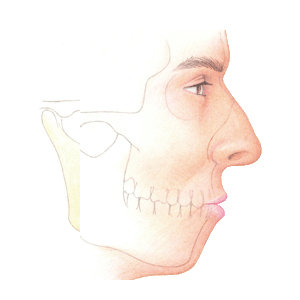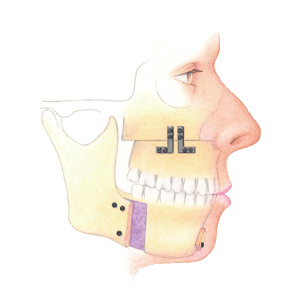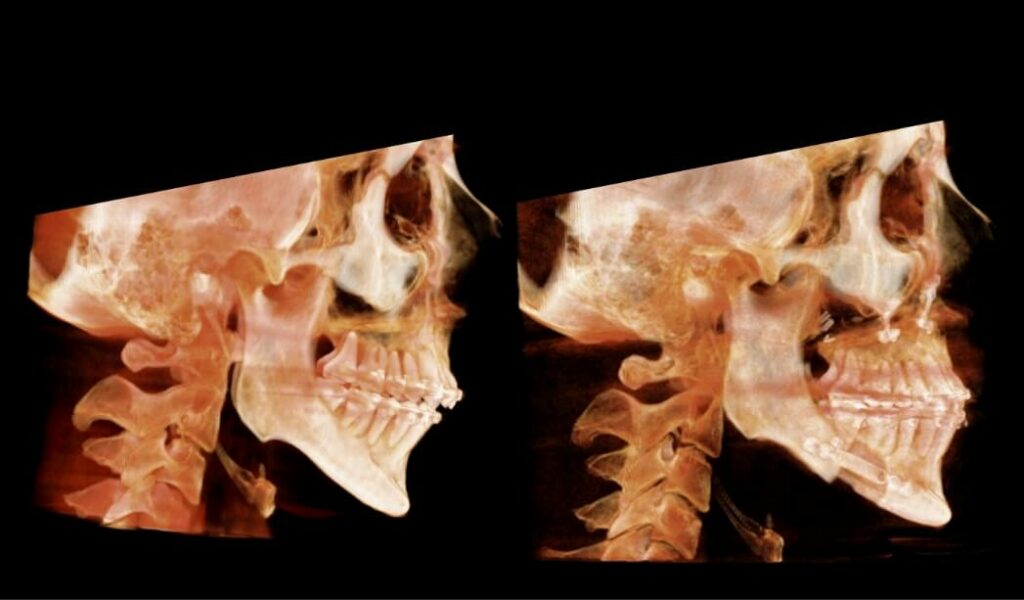Li KK. Surgical Therapy for Adult Obstructive Sleep Apnea. Sleep Med Rev; 9(3): 201-209, 2005.
Overview of Maxillomandibular Advancement
The airway is, in essence, confined by the upper and lower jaws. By moving the upper jaw (maxilla) and lower jaw (mandible) forward, the entire airway can be enlarged. This procedure serves as the most effective surgical treatment for obstructive sleep apnea. It is performed on patients with moderate to severe obstructive sleep apnea as the only treatment, or when other procedures have failed. It is also performed in patients with significant jaw deformity that contributes to obstructive sleep apnea.
Maxillomandibular Advancement Treatment Course:
- Domestic patients require a total of 2 week stay in the area
- International patients require a total of 3 week stay in the area
Preoperative requirement:
- CT scan at least 2 weeks prior to surgery
- Dental impression or scanning of your teeth 2-3 weeks prior to surgery
- Active movement of the teeth must stop 6-8 weeks before surgery if you have braces
- Covid Test 24-48 hours prior to surgery
Intraoperative and hospital course:
- Surgery duration is approximately 4 hours under general anesthesia
- Hospitalization is 1-2 days
Postoperative management:
- Sleep with head elevated (two pillows so the head is above the heart)
- No nose blowing for at least 10 days
- Apply ice to cheeks to reduce swelling for 2-3 days
- Pain control consists of Hydrocodone every 4 hours
- Occasionally, Dr. Li may add another medication to supplement the Hydrocodone
- Pain medication is typically needed for 7-10 days
- No exercise for 4 weeks but walking is encouraged starting post-surgery day 1
- Liquid diet for 4 weeks after surgery
- Soft food diet such as well-cooked pasta, fish, tofu after chewing is resumed
References:
Li KK, Meara JG, Alexander A. Location of the Descending Palatine Artery in Relation to the Le Fort I Osteotomy. Journal of Oral and Maxillofacial Surgery; 54(7):822-825, 1996.
Li KK. Experimental Study of the Safety of Simultaneous Nasal and Le Fort I Osteotomies. Journal of Oral and Maxillofacial Surgery; 55(4):371-374, 1997.
Riley RW, Powell NB, Guilleminault C, Pelayo R, Troell RJ, Li KK. Obstructive Sleep Apnea Surgery: Risk Management and Complications. Otolaryngology – Head and Neck Surgery; 117(12):648-652, 1997.
Li KK, Riley RW, Powell NB, Troell RJ, Guilleminault C. Overview of Phase II Surgery for Obstructive Sleep Apnea Syndrome. Ear Nose and Throat Journal; 78(11):851-857, 1999.
Li KK, Powell NB, Riley RW, Zonato A, Troell R, Guilleminault C. Post-operative Airway Findings after Maxillomandibular Advancement for Obstructive Sleep Apnea Syndrome. Laryngoscope; 110:325-7, 2000.
Li KK, Powell NB, Riley RW, Zonato A, Gervacio L, Guilleminault C. Morbidly Obese Patients with Severe Obstructive Sleep Apnea Syndrome: Is Airway Reconstructive Surgery a Viable Option? Laryngoscope; 110;982-7, 2000.
Guilleminault C, Kim Y, Palombini L, Li K, Powell N. Upper Airway Resistance Syndrome and its Treatment. Sleep; 23:S197-S200, 2000.
Li KK, Powell NB, Riley RW, Guilleminault C. Maxillomandibular Advancement for Persistent OSA after Phase I Surgery in Patients Without Maxillomandibular Deficiency. Laryngoscope; 110:1684-1688, 2000.
Li KK, Riley RW, Powell NB, Gervacio L, Troell RJ, Guilleminault C. Obstructive Sleep Apnea Surgery: Patients’ Perspective and Polysomnographic Results. Otolaryngology – Head and Neck Surgery; 123:572-575, 2000.
Li KK, Riley RW, Powell NB, Zonato A. Fiberoptic Nasopharyngoscopy for Airway Monitoring Following Obstructive Sleep Apnea Surgery. Journal of Oral and Maxillofacial Surgery; 58:1342-1345, 2000.
Li KK, Riley RW, Powell NB, Guilleminault C. Patient’s Perception of the Facial Appearance After Maxillomandibular Advancement for Obstructive Sleep Apnea Syndrome. Journal of Oral and Maxillofacial Surgery; 59:377-380, 2001.
Li KK, Powell NB, Riley RW, Troell RJ, Guilleminault C. Long-term Results of Maxillomandibular Advancement Surgery. Sleep and Breathing; 4:137-139, 2000.
Li KK, Troell RJ, Powell NB, Riley RW, Guilleminault C. Uvulopalatopharyngoplasty, Maxillomandibular Advancement and the Velopharynx. Laryngoscope; 111:1075-1078, 2001.
Li KK, Powell NB, Riley RW, Guilleminault C. Distraction Osteogenesis in Adult Obstructive Sleep Apnea Surgery: A Preliminary Report. Journal of Oral and Maxillofacial Surgery; 60:6-10, 2002.
Li KK, Guilleminault C, Riley RW, Powell NB. Obstructive Sleep Apnea, Maxillomandibular Advancement and the Airway: A Radiographic and Dynamic Fiberoptic Examination. Journal of Oral and Maxillofacial Surgery; 60:526-530, 2002.
Riley RW, Powell NB, Li KK, Guilleminault C. Surgical Therapy for Obstructive Sleep Apnea Syndrome. In: Kryger M, editor. Principles and Practice of Sleep Medicine. 3rd edition. Philadelphia, PA: WB Saunders, 1999.
Li KK, Powell NB. Therapy – Hypopharyngeal Airway Surgery. In: Johnson J, Gluckman J and Sanders M, editors. Management of Obstructive Sleep Apnea. London, England, Martin Duntz Ltd. 2002.
Li KK, Powell NB, Riley RW. Surgical Management of Obstructive Sleep Apnea. In: Lee-Chiong T, Jr., Carskadon MA, Sateia MH, editors. Sleep Medicine. Philadelphia, PA, Hanley & Belfus, Inc. 2001.
Li KK, Powell N, Riley R. Postoperative Management of the Obstructive Sleep Apnea Patients. Oral and Maxillofacial Surgery Clinics of North America; 14:401-404, 2002.
Li KK. The Use of Distraction Osteogenesis in Sleep Apnea Surgery. Operative Technique of Otolaryngology-Head and Neck Surgery.
Li KK, Powell N. Lower Pharyngeal Airway Surgery: Maxillomandibular Advancement. In: Fairbanks, DNF, Mickelson SA and Woodson BT, editors. Snoring and Obstructive Sleep Apnea, 3rd edition. Philadelphia, PA, Lippincott, Williams & Wilkins, 2003.
Li KK, Riley R, Powell N. Complications of Obstructive Sleep Apnea Surgery. Oral and Maxillofacial Surgery Clinics of North America;15:297-304, 2003.
Li KK. Surgical Management of Obstructive Sleep Apnea. Clinics in Chest Medicine; 24:365-370, 2003.
Li KK. Obstructive Sleep Apnea – Surgical Treatment. In: Carney PR, Berry RB, Geyer JD, editors. Clinical Sleep Disorders. Philadelphia, PA, Lippincott, Williams & Wilkins, 2004.
Li KK. Surgery of the Tongue and Hypopharynx – Skeletal Technique (Maxilla and Mandible). In: Terris DJ, Goode RL, editors. Surgical Management of Sleep Apnea and Snoring. New York, New York, Marcel Dekker, Inc. 2005.
Li KK. Surgical Therapy for Obstructive Sleep Apnea Syndrome. Seminars in Respiratory and Critical Care Medicine; 26:80-88, 2005.




